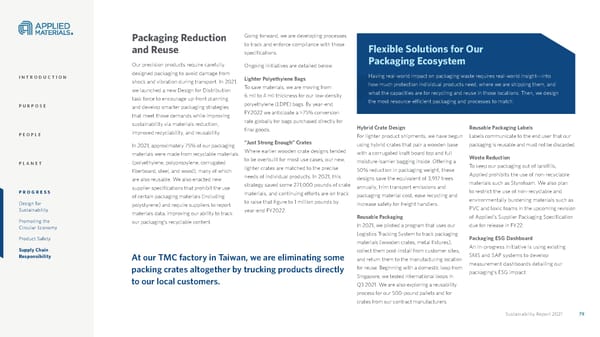Sustainability Report 2021 79 Packaging Reduction and Reuse Our precision products require carefully designed packaging to avoid damage from shock and vibration during transport. In 2021, we launched a new Design for Distribution task force to encourage up-front planning and develop smarter packaging strategies that meet those demands while improving sustainability via materials reduction, improved recyclability, and reusability. In 2021, approximately 75% of our packaging materials were made from recyclable materials (polyethylene, polypropylene, corrugated fiberboard, steel, and wood), many of which are also reusable. We also enacted new supplier specifications that prohibit the use of certain packaging materials (including polystyrene) and require suppliers to report materials data, improving our ability to track our packaging’s recyclable content. Going forward, we are developing processes to track and enforce compliance with those specifications. Ongoing initiatives are detailed below. Lighter Polyethylene Bags To save materials, we are moving from 6 mil to 4 mil thickness for our low-density polyethylene (LDPE) bags. By year-end FY2022 we anticipate a >75% conversion rate globally for bags purchased directly for final goods. “Just Strong Enough” Crates Where earlier wooden crate designs tended to be overbuilt for most use cases, our new, lighter crates are matched to the precise needs of individual products. In 2021, this strategy saved some 271,000 pounds of crate materials, and continuing efforts are on track to raise that figure to 1 million pounds by year-end FY2022. Hybrid Crate Design For lighter product shipments, we have begun using hybrid crates that pair a wooden base with a corrugated kraft board top and full moisture-barrier bagging inside. Offering a 50% reduction in packaging weight, these designs save the equivalent of 3,917 trees annually, trim transport emissions and packaging material cost, ease recycling and increase safety for freight handlers. Reusable Packaging In 2021, we piloted a program that uses our Logistics Tracking System to track packaging materials (wooden crates, metal fixtures), collect them post-install from customer sites, and return them to the manufacturing location for reuse. Beginning with a domestic loop from Singapore, we tested international loops in Q3 2021. We are also exploring a reusability process for our 500-pound pallets and for crates from our contract manufacturers. Reusable Packaging Labels Labels communicate to the end user that our packaging is reusable and must not be discarded. Waste Reduction To keep our packaging out of landfills, Applied prohibits the use of non-recyclable materials such as Styrofoam. We also plan to restrict the use of non-recyclable and environmentally burdening materials such as PVC and toxic foams in the upcoming revision of Applied’s Supplier Packaging Specification due for release in FY22. Packaging ESG Dashboard An in-progress initiative is using existing SMS and SAP systems to develop measurement dashboards detailing our packaging’s ESG impact. Flexible Solutions for Our Packaging Ecosystem Having real-world impact on packaging waste requires real-world insight—into how much protection individual products need, where we are shipping them, and what the capacities are for recycling and reuse in those locations. Then, we design the most resource-efficient packaging and processes to match. At our TMC factory in Taiwan, we are eliminating some packing crates altogether by trucking products directly to our local customers. INTRODUCTION PURPOSE PEOPLE PLANET PROGRESS Design for Sustainability Promoting the Circular Economy Product Safety Supply Chain Responsibility
 Applied Materials Sustainability Report Page 78 Page 80
Applied Materials Sustainability Report Page 78 Page 80